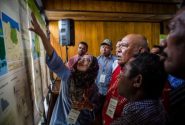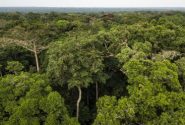BONN, Germany (15 May 2012)__A ‘step-wise approach’ for determining greenhouse gas reference emission levels (RELs) from forests, adopted at the 2011 UNFCCC talks in Durban, should help countries overcome a major technical hurdle to beginning REDD+ activities, according to a team of scientists presenting more details on the approach at UN climate talks in Bonn today.
CIFOR scientist Louis Verchot called the decision on RELs at Durban “a major step forward for REDD+”, because it meant that countries could begin developing their RELs with available data and update them as new information became available — one less stumbling block for developing nations in getting REDD+ schemes up and running.
Negotiators at the UN talks in Durban in December adopted the tiered approach proposed by members of a partnership in CIFOR’s Global Comparative Study on REDD+.
The question of how these RELs should be set for each country had been in discussion for several years, not least because many developing nations (a recent study suggests as many as 89 out of 99 tropical countries) do not yet have the capacity to fulfill the monitoring requirements for REDD+.
The approach identifies a series of methods and approaches that increase in complexity and accuracy as countries develop better data on changes in forest areas and forest carbon stocks. The simplest methods in the first step of the approach uses internationally available forest area data so that all developing nations can begin implementing REDD+.
A summary of the method to explain the details to policy makers was published this week and is being presented at the Subsidiary Bodies meeting of the UNFCCC in Bonn.
“Developing forest RELs may appear a daunting task, but what we have to keep in mind is that we don’t have to reach a sophisticated REL that takes into account complex and country-specific factors all at once. We can do it gradually,” said Verchot, who co-authored the policy brief entitled ‘A step-wise framework for setting REDD+ forest reference emission levels and forest reference levels’.
In the REDD+ mechanism, forest-rich developing countries are rewarded for protecting, restoring and sustainably managing forests — but in order to receive payments they must demonstrate that emissions from deforestation and forest degradation have been reduced, and also prove that they have sequestered carbon if they are undertaking conservation and forest rehabilitation activities.
In order to measure this, the United Nations Framework Convention on Climate Change (UNFCCC) requires that countries estimate RELs. RELs – the business-as-usual levels if no REDD+ policies and measures are implemented – are crucial for ensuring that emission cuts are measured against a realistic benchmark and that REDD+ actually contributes to slowing the pace of climate change.
The major advantage of the step-wise approach proposed in the study is that it can reflect different national circumstances and therefore ensure broad participation in REDD+ by enabling developing countries to develop relatively simple forest reference emission levels (REL) that can be improved over time. This mirrors the three phases of REDD+ with which countries must comply: readiness, results-based demonstration activities, and fully measured, reported and verified activities.
The first step will only require countries to set RELs based on data of forest area and carbon stock estimates that is already available, for example, in reports published by the Food and Agriculture Organization of the United Nations (FAO). “Although the first step of the approach is simple and the results may have a high level of uncertainty, it allows all countries to initiate REL activities,” explained Verchot.
Step 2 makes use of country-specific data, including national drivers of deforestation, while step 3 uses spatially explicit information on drivers and activities that cause deforestation and forest degradation. This last step is essential to ensure “the cost-efficiency and environmental integrity of REDD+” in Phase 3, when countries are compensated based on measured, reported and verified emission cuts.
With six months remaining until the next UN climate talks are held in Doha, Qatar, the Bonn climate talks also need to review how the accuracy of reporting on emissions will be verified, either nationally or independently, said Verchot.
“By the next UN climate talks, SBSTA will need to make several important decisions on how emissions reductions in REDD will be measured and reported and what the verification requirements will be. As researchers, we are trying to provide timely analyses of our research results to inform the policy makers and help them reach sound decisions. Figuring out how to move forward on RELs adds one more piece to the puzzle that will help developing nations move ahead with REDD+.”
CIFOR will hold a side event entitled “Insights into REDD+ realities: Politics, MRV and benefit sharing” at the sidelines of SBSTA meeting in Bonn, Germany. Louis Verchot will present this study at the event, which will take place on Wednesday, 16 May, at 18:15–19:45 in WIND room at the Ministry of Environment building.
We want you to share Forests News content, which is licensed under Creative Commons Attribution-NonCommercial-ShareAlike 4.0 International (CC BY-NC-SA 4.0). This means you are free to redistribute our material for non-commercial purposes. All we ask is that you give Forests News appropriate credit and link to the original Forests News content, indicate if changes were made, and distribute your contributions under the same Creative Commons license. You must notify Forests News if you repost, reprint or reuse our materials by contacting forestsnews@cifor-icraf.org.
Further reading
A step-wise framework for setting REDD+ forest reference emission levels and forest reference levels
Assessing capacities of non-Annex I countries for national forest monitoring in the context of REDD+
Considering drivers and data uncertainties for developing reference emission levels (presentation)
Durban talks both good and bad for REDD+, says expert
REDD+ best chance for progress on climate change at Durban, says scientist














